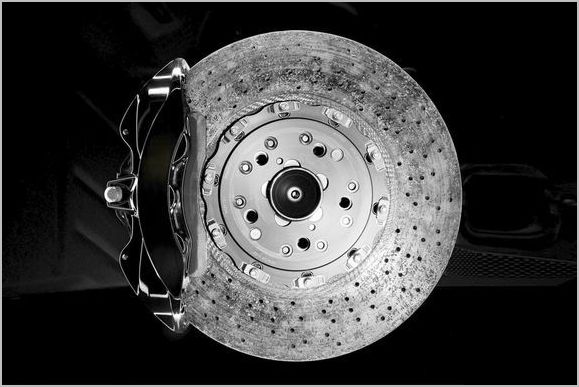
Unique properties of ceramic brakes
Standard disc brakes consist of cast iron or steel discs and pads where the filler is reinforced with metal shavings. When asbestos was the basis of friction linings, there were no special questions about the composition, but then it turned out that asbestos fibers and dust released during braking have strong carcinogenic properties. The use of asbestos was banned, and various organic compounds began to be used in pads. Their properties turned out to be insufficient under extreme conditions.

What is ceramics and why is it
Ceramics can be considered anything that is not organic or metal. It was its properties that turned out to be what is needed for the friction linings of automobile brakes working in difficult conditions.
The disc brake has great advantages over others, but its feature is the small pad area. And high braking power implies the rapid release of a huge amount of thermal energy. As you know, energy is proportional to the power and the time for which it is released. And both determine the braking efficiency of the car.
The release of significant energy in a limited volume in a short time, that is, when the heat does not have time to dissipate into the surrounding space, in accordance with the same physics, leads to an increase in temperature. And here the traditional materials from which the brake linings are made can no longer cope. The use of ventilated disks can stabilize the thermal regime in the long term, but it does not save from local overheating in the contact zone. The pad material literally evaporates, and the resulting fractions create a slippery environment, the friction coefficient drops sharply, and the brakes fail.

Ceramics based on various inorganic substances, usually silicon carbide, can withstand much higher temperatures. Moreover, when warmed up, they only enter the optimal mode, providing the highest coefficient of friction.
Without reinforcement, the lining will not be able to have sufficient strength; for this, various fibers are introduced into the composition. Most often it is copper shavings, carbon fiber is used for sports brakes. The reinforcing material is mixed with ceramics and baked at a high temperature.
Depending on the nature of the application, the formulation of the pads may be different. This is determined by the purpose of the brakes, street, sports or extreme type pads stand out. They have different operating temperatures and limiting capabilities. But the general will be to increase the efficiency of work in difficult conditions:
- friction coefficient stability;
- disc wear minimization;
- reduction of operating noise and vibration load;
- high resistance and safety of the material at high operating temperatures.
With the use of ceramics, not only pads are made, but also discs. At the same time, increased wear is not observed in case of mixed use, ceramic pads do not lead to accelerated erasure of steel and cast iron discs. Ceramic rotors (discs) are distinguished by high strength under thermal loading conditions, which makes it possible not to make them unacceptably large, and also do not leave residual deformations during sudden cooling. And with such heating, even natural cooling leads to significant temperature changes in a limited time.

Pros and cons of ceramic brakes
It has already been said about the advantages of ceramics, it can be supplemented with not so obvious factors:
- such mechanisms have less weight and dimensions with equal efficiency, which reduces such an important indicator of suspension dynamics as unsprung mass;
- there is no release of harmful substances into the environment;
- with an increase in temperature, the efficiency of the brakes does not decrease, but rather increases, which sometimes requires preheating;
- reinforcing material is not subject to high-temperature corrosion;
- the properties of ceramics are well predicted and programmed when selecting a recipe, which makes it possible to produce similar parts for a wide variety of applications;
- combinations of ferro-containing parts with ceramic ones are possible, it is not necessary to use the same discs for ceramic pads;
- ceramic parts are very durable when working in gentle conditions.
It could not do without minuses, but there are not so many of them against the background of advantages:
- ceramic brakes are still more expensive;
- especially effective compositions require preheating, since the coefficient of friction decreases with decreasing temperature;
- under a certain combination of conditions, they can create a hard-to-remove creak.
Obviously, ceramic brake parts have no alternative in spirited driving and sports. In other cases, their high price makes one think about the appropriateness of their use.

